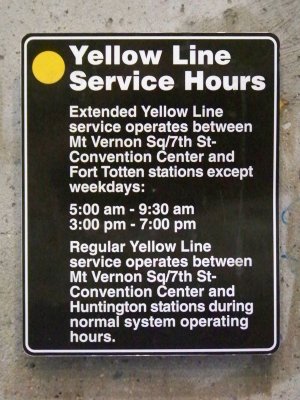Yellow Line to Fort Totten…
6 minute read
October 21, 2010, 9:49 PM
On Tuesday, when I was perusing the Twitter while riding the Red Line home from work, I noticed a tweet that read, “Can’t for life of me figure out why @WMATA stops Yellow trains at Mt Vernon Sq during rush hr. I hear Ft Totten is lovely this time of year.” I gave as good of an explanation as 140 characters would allow, and got a thank you for my efforts along with expression of hope for the addition of a pocket track at Fort Totten. I then explained that it would be far more economical just to send trains to Greenbelt than to reconstruct things north of Fort Totten.
I felt my explanation was a little weak, mainly due to the 140 character limit that the Twitter imposes. So to @jeremycluchey, here’s a better explanation of the Fort Totten situation.
The short of it is that Fort Totten was never designed for turning trains in regular service with the full Green Line. While there is a switch at Fort Totten allowing trains to change tracks, its main purpose for existence there was to allow trains to cross over while the Green Line did not exist south of Fort Totten – thus Fort Totten’s lower level was being used as a stub-end terminal. From 1993 to 1999, one may recall, there was a gap in the Green Line. The segment of the line north of Gallery Place to U Street opened in 1991, and then the segment from Fort Totten to Greenbelt opened in 1993. The mid-city segment linking the two sections (including Columbia Heights and Georgia Ave-Petworth) didn’t open until 1999. That’s why the Green Line Commuter Shortcut existed in the 1990s.
That allowed riders in the northern segment of the Green Line a one-seat ride to the downtown area and the major transfer stations. That service – another case where the tracks were not designed for the service pattern being run – started at Greenbelt, and followed the E Route (Green Line north of Gallery Place) to just north of Fort Totten. There, the trains used a single-track connection around Fort Totten (bypassing the station itself) to join the B Route (Red Line east of Metro Center), basically running Red Line service as far as Farragut North, where a pocket track exists to turn trains. Once the mid-city segment opened, the shortcut was discontinued, as Green Line trains originating at Greenbelt could now reach the downtown area and major transfer stations by going straight through as intended.
Now fast forward to 2006, when Yellow Line service was extended from Mt. Vernon Square (where a pocket track exists to turn trains) to Fort Totten during off-peak hours. To accomplish this service pattern, Yellow Line trains would go out of service at Fort Totten, much like they do at Mt. Vernon Square, and then cross over to the other track using the switch north of the station. The track configuration for that switch looks basically like this:
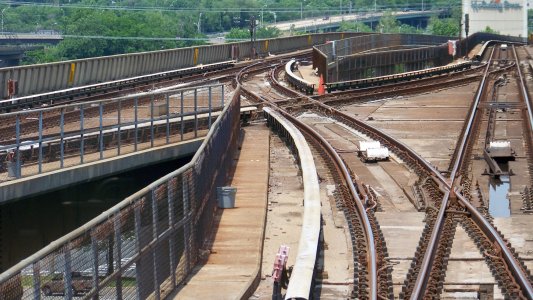
(This is the switch at Huntington, but you get the idea. The Fort Totten switch is in a tunnel, but of the same basic design.)
Compare to a proper pocket track, which looks like this:
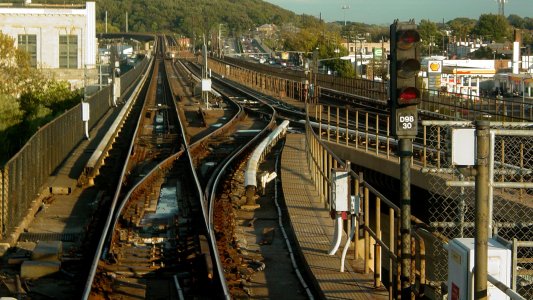
(This is the pocket track east of Stadium-Armory, of the same basic design as Mt. Vernon Square. Mt. Vernon Square’s pocket track is in a tunnel rather than above ground.)
Thus the kicker to using Fort Totten, normally a through station, as a terminal, is that there’s no real place for trains to dwell in order to establish the headway (and thus maintain the schedule) for southbound trains to Huntington. During off-peak hours, Yellow Line trains can dwell on the mainline because train frequencies are low enough that it won’t disrupt Green Line service to do so. During rush hour, the frequencies are too high. For Yellow Line trains to dwell on the mainline during rush hour, they would jam the Green Line. Even if trains crossed over to the southbound track and immediately headed back to Huntington, that could cause problems as well, since there would be no semblance of a schedule, and owing to Metro’s two-track configuration, it could cause delays on the Yellow, Green, and Blue Lines (since Yellow Line trains also share track with Blue Line trains for some distance in Virginia), since the only place to establish train headways would be at Huntington. Huntington can only handle two trains at once, and so there could also be backups at Huntington. Basically a lose-lose situation for Metro and the passengers. Thus it makes operational sense for Metro to terminate at Mt. Vernon Square, where there is a pocket track to allow these Yellow Line trains to dwell at the end of the line off the mainline – allowing Green Line trains to pass in both directions.
The alternative to terminating at Mt. Vernon Square, or sending the schedule into chaos by terminating at Fort Totten during rush hour, would be to send Yellow Line trains all the way up to Greenbelt. That would admittedly be just perfect, however, as I understand it, there are equipment and funding issues that prevent this from being a viable option.
So we’ve got what we’ve got for now, I suppose. Installing a pocket track at Fort Totten would likely be more trouble than it would be worth, considering all the excavation that would need to be done, realignment of various tracks, plus significant disruption in train service. Plus it would tacitly say that you could cross what we really want – Yellow Line service to Greenbelt – off the list for good.
Then there’s the other matter, which @Metro_Fail tweeted about. He claimed to look like a Metro rookie due to being caught totally off guard by the trains’ terminating at Mt. Vernon Square. And I can sympathize, since the signage is kind of lacking in this department. I knew about it and learned it because I participate on a bunch of transit message boards, and we were discussing it from the moment it was proposed, before a single sign went up. Signage for the difference in Yellow Line service, from what I can tell, is mentioned on the station and train maps (but not on the maps at wmata.com, interestingly enough), and through small, inconspicuous signs at some stations. The maps, do, however, continue to show Mt. Vernon Square as a transfer station via the larger “bullseye” dot. Here’s an example of the sign, seen here on the lower level of Fort Totten:
I totally could understand missing this. That’s about the only indication other than the maps and the train destination signs that indicates that Yellow Line trains don’t go the whole route during peak periods. And I can totally understand someone seeing “YELLOW” and just getting on, since I’ve seen the way some commuters function on the Metro. All the other station signage reads like all Yellow Line trains go to Fort Totten all the time. Examples:
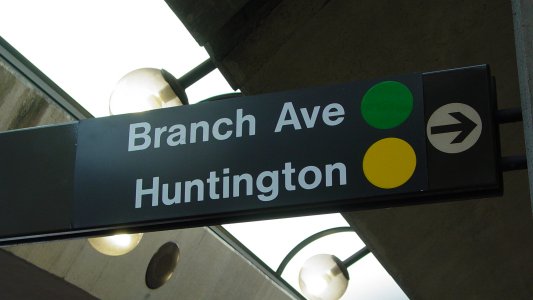
Signage at Fort Totten, with no indication that the Yellow Line does not service Fort Totten during peak hours.
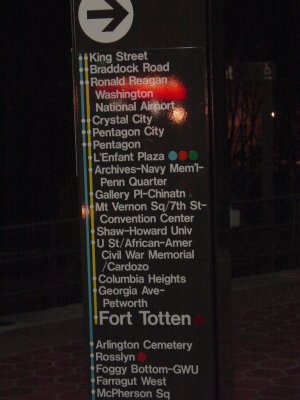
Then-newly installed signage at King Street showing Mt. Vernon Square as a regular through station and the terminal as Fort Totten. No green and yellow dots on Mt. Vernon Square.

Wall signage at Forest Glen showing a yellow dot next to Fort Totten with no indication of the limited service there.
So what we can conclude from this is that Metro didn’t really have a mechanism, when updating all the relevant signage for the service change, to indicate limited hours for certain services. It’s unfortunate, but ultimately something that we’re going to have to live with for a while, since Metro likely won’t update signage and maps again until they start sending trains between Franconia-Springfield and Greenbelt via the L Route (i.e. the Yellow Line bridge), or when the first phase of the line to Dulles (aka the Silver Line) opens, whichever comes first. Hopefully, with a more complex service pattern, including more services with limited hours (the Franconia-Springfield-to-Greenbelt routing is proposed as rush-only), Metro will start putting more effort into indicating exactly what services run when. And considering that a big redesign of the map is likely on its way, including potentially moving away from a color-based system, I think that things perhaps might look rosier in the future, but we’ll have to see, I suppose.
Song: A Yellow Line train to Fort Totten arrives at Crystal City
Quote: So hopefully the folks on the Twitter will find this explanation helpful...
Categories: WMATA










